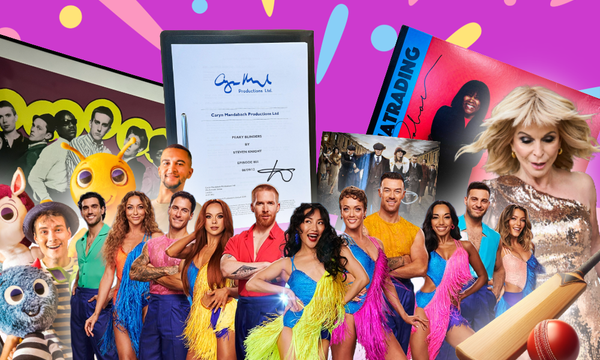Q&A with million selling German crooner Max Raabe ahead of concert at Symphony Hall
/ News 14 Jan 2020News Story
Million selling German crooner Max Raabe is the debonair, white-tie-and-tails wearing front man with the critically acclaimed Palast Orchester who are heading to British soil in Spring 2020 for their first ever UK Tour.
The orchestra was formed in Berlin in 1986, and over the past three decades has brought the music of the 1920s and 1930s to audiences across the world, from Tokyo to Tel Aviv to New York City – winning incredible rave reviews and scooping awards aplenty along the way.
Together, 57-year-old Max and 12 immensely talented musicians recreate the sounds of the Roaring Twenties with absolute attention to detail, charming modern-day audiences with songs first performed in the clubs of Weimar Germany and the silver screens of Europe and Hollywood.
Max has received numerous awards for his commitment to remembering the music of the era, including an ECHO Classic award for his interpretation of Mack the Knife. In November, their new MTV Unplugged album went straight into the Top 10 in the German pop charts.
Now UK audiences can experience a luxurious step back in time with a live performance of Max Raabe and the Palast Orchester in Eastbourne, Birmingham, London and Manchester.
This is being described as your first UK tour. The Palast Orchester has been together more than 30 years so why has it taken so long?
We have played some concerts, at the Cadogan Hall in London and Shepherd’s Bush Empire, and invitations to festivals like Twinwood (in 2012) and the Secret Garden Party. We had wonderful concerts and it was always very successful. In Spring, I have my second solo concert at Wigmore Hall in London, which is a wonderful concert hall. It’s not so easy to go to your island for artists from Europe. I think you have incredible artists and musicians – maybe that’s the reason why.
How would you describe Max Raabe and the Palast Orchester?
We’re a 13-piece orchestra playing the music of the 1920s and 1930s. We have four saxophones, two trumpets, one trombone, rhythm section with sousaphone, double bass, drums, guitar, banjo, and a violin player – she’s the only lady in the orchestra. This is by chance.
Our first violin was played by the girlfriend of one of our saxophone players. And when he left, we asked a student of ours to play for a concert and he said ‘for one concert I will do that, but I have no time to come with you to play concerts and stay in your band’. But then we realised how wonderful it is to have a woman in the orchestra. Our current violinist Cecilia Crisafulli has been with us for 13 years.
What was it that first interested you in this specific style of music?
The music was always there when I was a child. On each Sunday there were black and white films on TV. Not only German and Austrian films from the 1920s and 1930s, but also from the United States with Fred Astaire. There was always a scene where somebody was singing, and a band was playing in a big hotel.
In my father’s record collection there was an instrumental song called Crazy About Hilde. It was funny and fast, but there was a melancholy sub-note in that song by the saxophones and the vibrato of the trumpet – it was like listening through a pipe into another room, another era. So I went to flea markets in the next big town, Münster, and bought some of these 78 records, not only German but also sometimes English songs.
Where do you find all the original arrangements from the 1920s and 1930s?
The first we found in flea markets, then we found a big old publishing company in Berlin. There was a company who asked us to do a record and said ‘we have so many records in our cellar and archives, let’s have a look and maybe you can find some’.
A few years ago we had a tour through the States including a concert in Chicago, and a few weeks before somebody said ‘do you know there is a big library in Chicago with original stock arrangements from the Twenties and Thirties?’. We went and found around 30 arrangements and just had to pay the copy for them. It was like Christmas on one day, incredible.
How do you decide what to perform for each concert? And what can UK audiences expect?
We have more than 600 songs in our repertoire. We mix it up with songs I compose and play songs of the countries we’re travelling through. When we have a tour through somewhere like Scandinavia we do one programme, when we go to Japan we sing some Japanese songs. Recently we had a concert in Milan and the programme had five Italian songs.
One of the songs we’ll play in the United Kingdom is I Won’t Dance, a wonderful arrangement from 1935 which we found in Chicago. We have Noel Coward songs and some by Al Bowlly. We play in the way it was played in the early 1930s, the pre-swing era.
How do you feel when you stand at the front of the orchestra singing these songs?
It makes me feel lucky because I always discover new colours and variations. My aim is to entertain the audience and transport them out of reality. The music was written to take its audience away from their everyday problems. And it still works today.
More stories

Birmingham Town Hall receives blue plaque commemorating Charles Dickens’ first public reading of A Christmas Carol

B:Music launches special fundraising auction and lottery to support refurbishment of Town Hall

Birmingham Town Hall to receive blue plaque commemorating Charles Dickens’ first public reading of A Christmas Carol